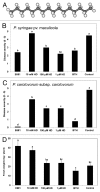One shot-two pathogens blocked: exposure of Arabidopsis to hexadecane, a long chain volatile organic compound, confers induced resistance against both Pectobacterium carotovorum and Pseudomonas syringae
- PMID: 23603940
- PMCID: PMC3906419
- DOI: 10.4161/psb.24619
One shot-two pathogens blocked: exposure of Arabidopsis to hexadecane, a long chain volatile organic compound, confers induced resistance against both Pectobacterium carotovorum and Pseudomonas syringae
Abstract
Bacteria and plant derived volatile organic compounds have been reported as the chemical triggers that elicit induced resistance in plants. Previously, volatile organic compounds (VOCs), including acetoin and 2,3-butanediol, were found to be emitted from plant growth-promoting rhizobacteria (PGPR) Bacillus subtilis GB03, which had been shown to elicit ISR and plant growth promotion. More recently, we reported data that stronger induced resistance could be elicited against Pseudomonas syringae pv maculicola ES4326 in plants exposed to C13 VOC from another PGPR Paenibacillus polymyxa E681 compared with that of strain GB03. Here, we assessed whether another long hydrocarbon C16 hexadecane (HD) conferred protection to Arabidopsis from infection of a biotrophic pathogen, P. syringae pv maculicola and a necrotrophic pathogen, Pectobacterium carotovorum subsp carotovorum. Collectively, long-chain VOCs can be linked to a plant resistance activator for protecting plants against both biotrophic and necrotrophic pathogens at the same time.
Keywords: PGPR; Paenibacillus polymyxa; Pseudomonas syringae; induced systemic resistance; volatile organic compound.
Figures

Similar articles
-
Chronicle of a Soil Bacterium: Paenibacillus polymyxa E681 as a Tiny Guardian of Plant and Human Health.Front Microbiol. 2019 Mar 15;10:467. doi: 10.3389/fmicb.2019.00467. eCollection 2019. Front Microbiol. 2019. PMID: 30930873 Free PMC article. Review.
-
Induced resistance by a long-chain bacterial volatile: elicitation of plant systemic defense by a C13 volatile produced by Paenibacillus polymyxa.PLoS One. 2012;7(11):e48744. doi: 10.1371/journal.pone.0048744. Epub 2012 Nov 28. PLoS One. 2012. PMID: 23209558 Free PMC article.
-
Plant growth-promoting archaea trigger induced systemic resistance in Arabidopsis thaliana against Pectobacterium carotovorum and Pseudomonas syringae.Environ Microbiol. 2019 Mar;21(3):940-948. doi: 10.1111/1462-2920.14486. Epub 2019 Jan 21. Environ Microbiol. 2019. PMID: 30461142
-
Elicitation of induced resistance against Pectobacterium carotovorum and Pseudomonas syringae by specific individual compounds derived from native Korean plant species.Molecules. 2013 Oct 16;18(10):12877-95. doi: 10.3390/molecules181012877. Molecules. 2013. PMID: 24135942 Free PMC article.
-
Dynamic chemical communication between plants and bacteria through airborne signals: induced resistance by bacterial volatiles.J Chem Ecol. 2013 Jul;39(7):1007-18. doi: 10.1007/s10886-013-0317-9. Epub 2013 Jul 24. J Chem Ecol. 2013. PMID: 23881442 Free PMC article. Review.
Cited by
-
Chronicle of a Soil Bacterium: Paenibacillus polymyxa E681 as a Tiny Guardian of Plant and Human Health.Front Microbiol. 2019 Mar 15;10:467. doi: 10.3389/fmicb.2019.00467. eCollection 2019. Front Microbiol. 2019. PMID: 30930873 Free PMC article. Review.
-
Plant growth promotion via priming with volatile organic compounds emitted from Bacillus vallismortis strain EXTN-1.Front Microbiol. 2025 Jan 10;15:1524888. doi: 10.3389/fmicb.2024.1524888. eCollection 2024. Front Microbiol. 2025. PMID: 39867490 Free PMC article.
-
Effects of phosphorus sources on volatile organic compound emissions from Microcystis flos-aquae and their toxic effects on Chlamydomonas reinhardtii.Environ Geochem Health. 2018 Aug;40(4):1283-1298. doi: 10.1007/s10653-017-0055-y. Epub 2017 Dec 20. Environ Geochem Health. 2018. PMID: 29264818
-
(S)-Reutericyclin: Susceptibility Testing and In Vivo Effect on Murine Fecal Microbiome and Volatile Organic Compounds.Int J Mol Sci. 2021 Jun 15;22(12):6424. doi: 10.3390/ijms22126424. Int J Mol Sci. 2021. PMID: 34203988 Free PMC article.
-
Evaluation and identification of metabolites produced by Cytobacillus firmus in the interaction with Arabidopsis thaliana plants and their effect on Solanum lycopersicum.Curr Res Microb Sci. 2024 Nov 13;8:100312. doi: 10.1016/j.crmicr.2024.100312. eCollection 2025. Curr Res Microb Sci. 2024. PMID: 39717210 Free PMC article.
References
-
- Kloepper JW. Plant growth-promoting rhizobacteria as biological control agents in Metting, F.B., ed. Soil Microbial Ecology: Applications in Agricultural and Environmental Management, New York, NY: Marcel Dekker Inc, 1993: 255-274.
-
- Ryu CM, Kim J, Choi O, Kim SH, Park CS. Improvement of biological control capacity of Paenibacillus polymyxa E681 by seed pelleting on sesame. Biol Control. 2006;39:282–9. doi: 10.1016/j.biocontrol.2006.04.014. - DOI
-
- Ryu CM, Murphy JF, Mysore KS, Kloepper JW. Plant growth-promoting rhizobacteria systemically protect Arabidopsis thaliana against Cucumber mosaic virus by a salicylic acid and NPR1-independent and jasmonic acid-dependent signaling pathway. Plant J. 2004;39:381–92. doi: 10.1111/j.1365-313X.2004.02142.x. - DOI - PubMed
Publication types
MeSH terms
Substances
LinkOut - more resources
Full Text Sources
Other Literature Sources
